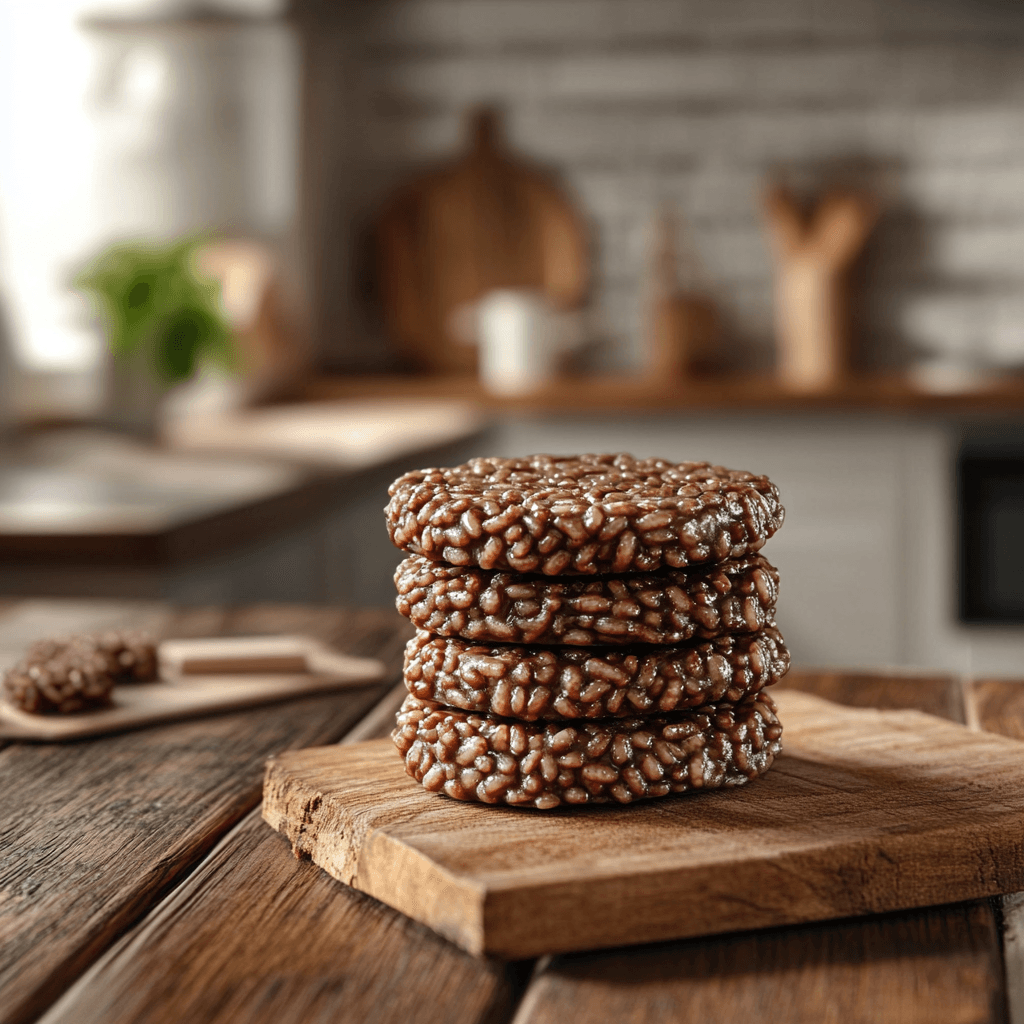
Chocolate rice cakes are a popular snack known for their crunchy texture and sweet coating. They are often marketed as a healthy alternative to traditional sweet treats like cookies or candy bars. But how healthy are they, really?
In recent years, more people have become health-conscious and started paying closer attention to their snack choices. Rice cakes, especially chocolate-flavored ones, are often perceived as a guilt-free option, especially for those looking to manage their weight or maintain a gluten-free diet. However, appearances can be deceiving, and it’s essential to examine the nutritional facts and ingredients to determine if they truly align with a healthy lifestyle.
This article delves into the nutritional profile, potential benefits, and drawbacks of chocolate rice cakes. It also offers practical advice on how to enjoy them without compromising your health goals.
Table of Contents
Nutritional Composition
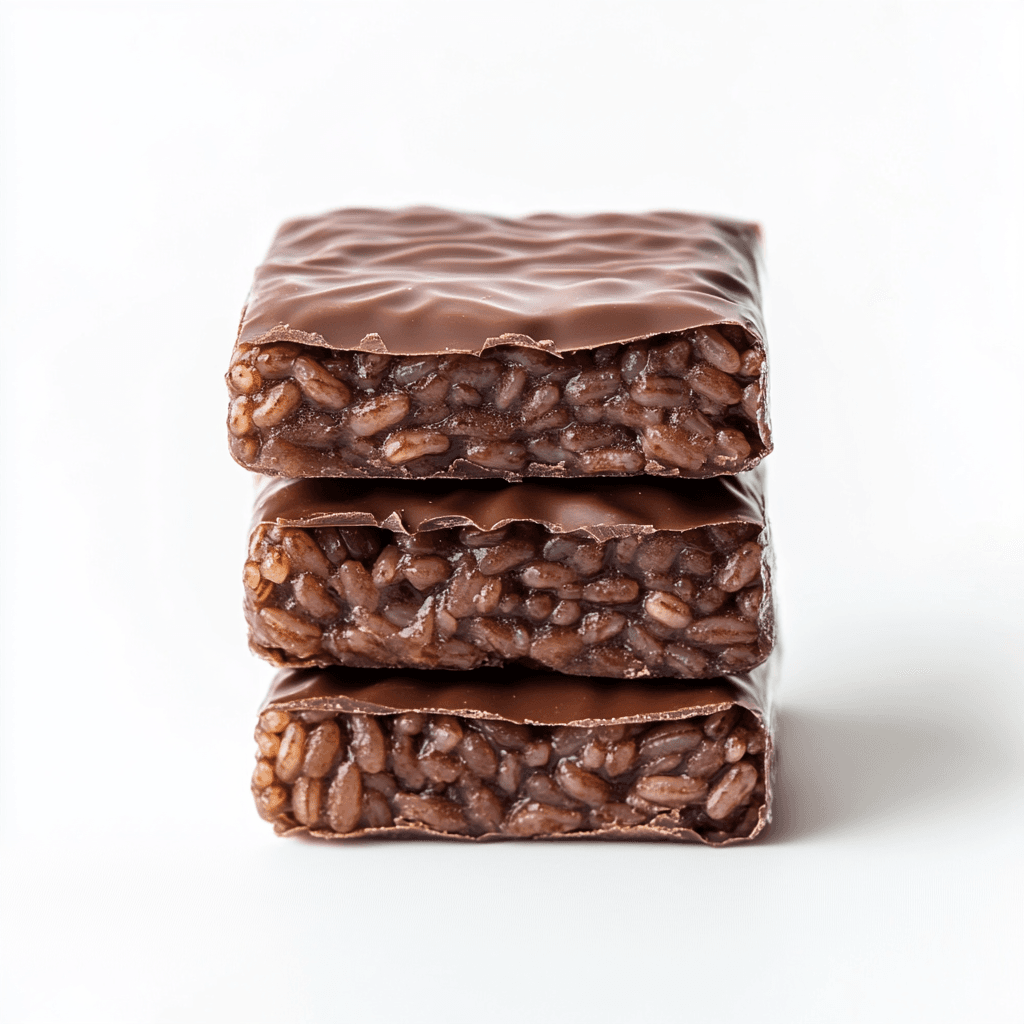
When evaluating whether chocolate rice cakes are healthy, it’s essential to look at their nutritional content. While they may appear simple and low-calorie, the combination of rice and coating can vary widely in terms of healthiness.
Overview of Chocolate Rice Cakes’ Ingredients
It typically consist of puffed rice as the base and a layer of chocolate or chocolate-flavored coating. Depending on the brand, additional ingredients may include sugar, oils, and preservatives. Some brands also fortify their rice cakes with vitamins and minerals, though this is not standard.
The primary ingredients in chocolate rice cakes are:
- Puffed Rice: The main component, usually made from white or brown rice.
- Chocolate Coating: Often includes sugar, cocoa, and milk powder.
- Sweeteners: High-fructose corn syrup or cane sugar may be used.
- Fats: Some contain palm oil or hydrogenated fats to enhance texture and flavor.
While these ingredients are generally safe, their proportion and quality greatly influence the overall nutritional value.
Calories and Macronutrient Breakdown
A standard cake weighs around 10–15 grams and contains approximately:
- Calories: 60–90 per rice cake.
- Carbohydrates: 10–15 grams, mostly from rice and added sugars.
- Protein: 1–2 grams, which is minimal.
- Fat: 2–4 grams, depending on the chocolate layer.
Chocolate rice cakes are typically low in protein and fat, making them a less balanced snack when consumed alone.
Vitamins and Minerals
Most chocolate rice cakes lack significant amounts of vitamins or minerals. However, some brands made from brown rice may contain trace amounts of:
- Magnesium
- B Vitamins
- Iron
Even so, these nutrients are typically present in small quantities and are not enough to contribute meaningfully to your daily dietary needs.
Nutritional Variations by Brand
The nutritional value of cakes can vary between brands. For example:
- Low-Sugar Options: Some brands use stevia or other sugar alternatives to reduce calories.
- Organic Varieties: These often avoid artificial flavors, colors, and preservatives.
- High-Sugar Brands: Certain brands may include up to 8 grams of sugar per rice cake, increasing the calorie count and glycemic impact.
Understanding these variations can help you choose a product that aligns better with your health goals.
Health Benefits of Chocolate Rice Cakes
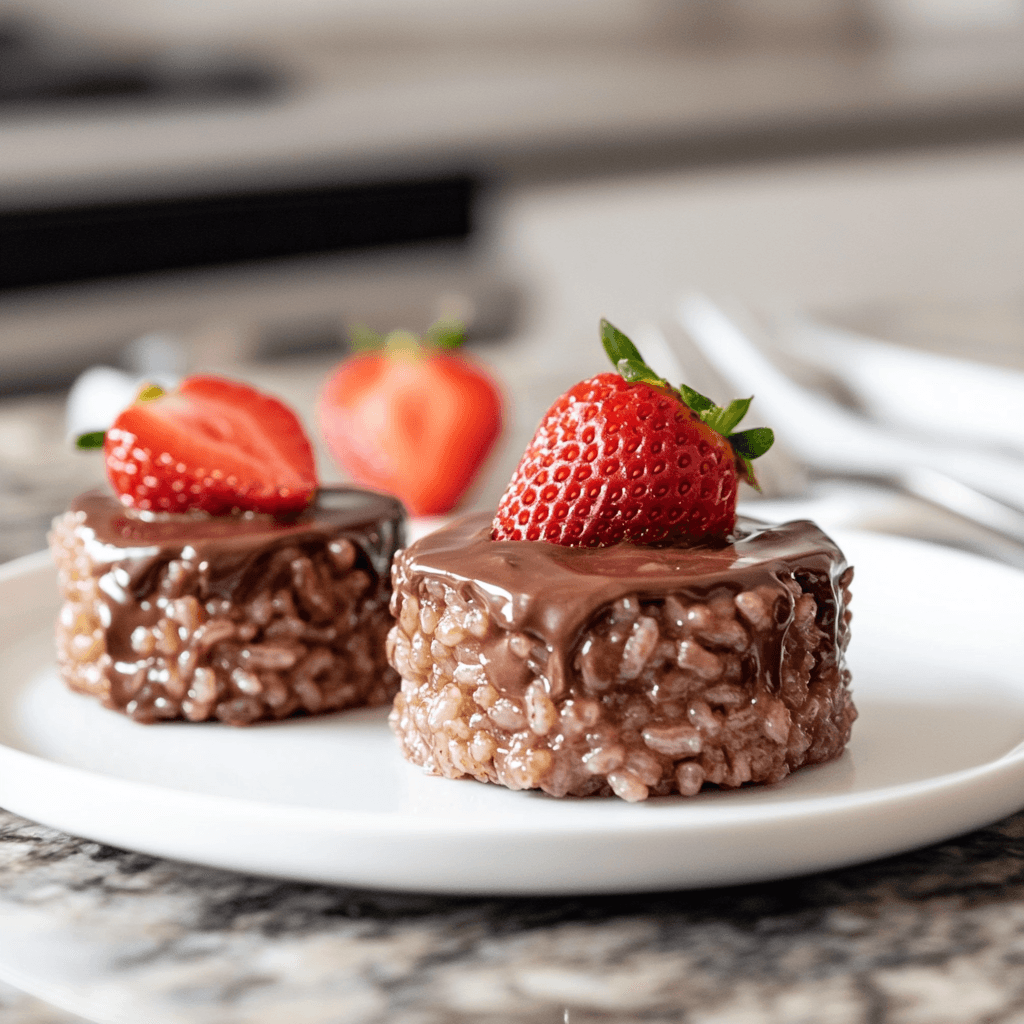
While aren’t a superfood, they offer several advantages that make them appealing to those seeking convenient snack options. Below are some of the key health benefits of including chocolate rice cakes in your diet.
Low-Calorie Snack Option
Recipe cakes are a relatively low-calorie snack compared to other sweet treats. For example, a single rice cake contains about 60–90 calories, which is far less than most chocolate bars, cookies, or pastries.
For individuals watching their caloric intake, chocolate rice cakes can be a satisfying alternative that satisfies a sweet craving without significant calorie consumption. This makes them especially useful for those managing their weight.
Gluten-Free Benefits
Since rice is naturally gluten-free, Recipe are an excellent snack for individuals with gluten intolerance or celiac disease. Unlike many processed snacks, they are typically free of wheat or other gluten-containing grains, ensuring accessibility to a broader audience.
However, it’s crucial to check the packaging, as cross-contamination or added ingredients could compromise the gluten-free status of some brands. Certified gluten-free labels provide added assurance.
Convenience and Versatility
Chocolate rice cakes are convenient and portable, making them an ideal snack for busy lifestyles. They don’t require refrigeration and are easy to pack for work, school, or outdoor activities.
Additionally, their versatility allows them to be paired with other nutrient-rich foods to create a more balanced snack. For example:
- Add a layer of nut butter for protein and healthy fats.
- Top with fresh fruit for fiber and antioxidants.
- Sprinkle with seeds like chia or flax for added nutrition.
These pairings enhance the nutritional profile of the rice cakes while adding variety to your diet.
Low-Fat and Cholesterol-Free
Most chocolate cakes are low in fat, particularly saturated fat, and contain no cholesterol. This makes them a better option for individuals aiming to reduce their intake of unhealthy fats, which are often linked to heart disease.
Mindful Snacking
Because chocolate rice cakes are individually portioned, they can encourage mindful eating. Instead of mindlessly consuming a large bag of chips or candy, eating one or two rice cakes provides a sense of portion control. This can be especially helpful for people trying to maintain a balanced diet without giving up their favorite snacks.
While chocolate rice cakes have these benefits, they should not be considered a nutrient-dense food. Instead, their role in a healthy diet depends on how they are consumed and what they are paired with.
Potential Downsides of Chocolate Rice Cakes
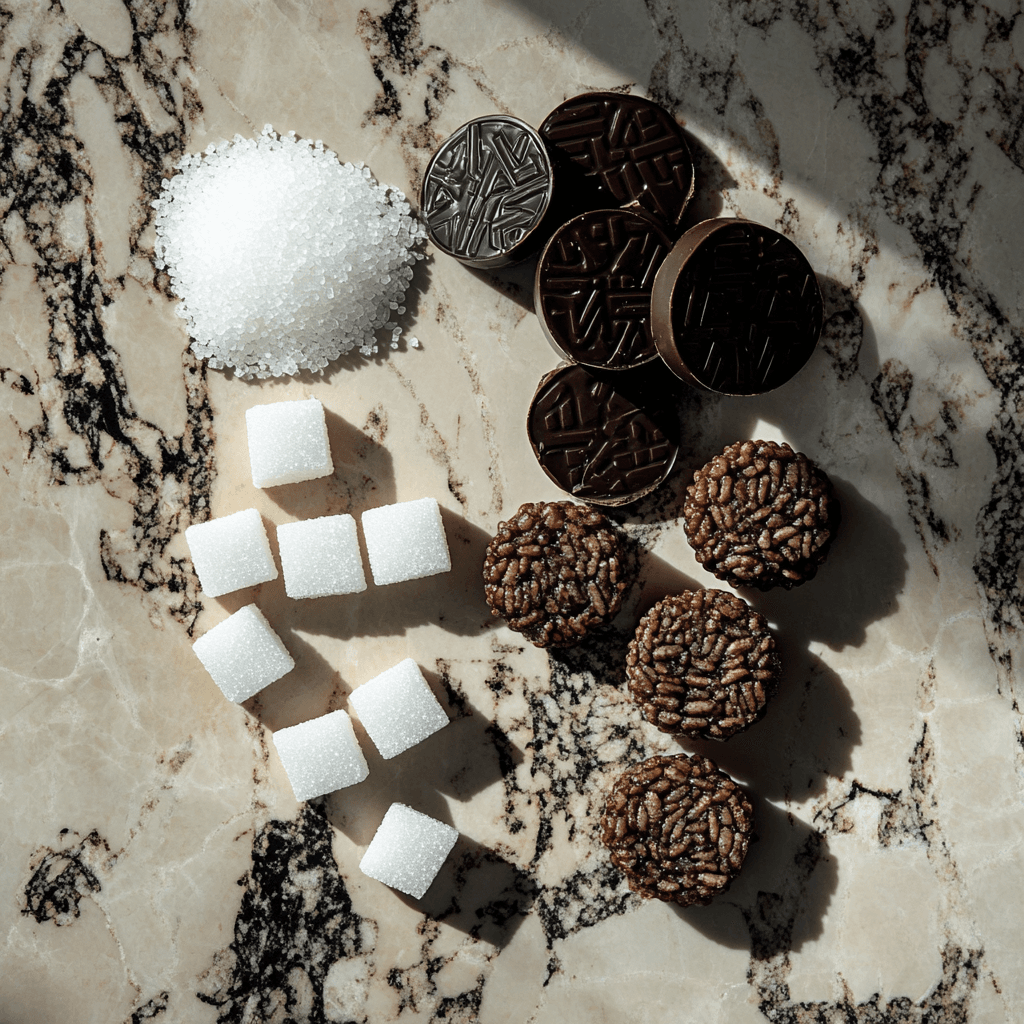
Despite their popularity as a low-calorie, gluten-free snack, chocolate rice cakes have some notable drawbacks. Understanding these limitations can help you make informed decisions about including them in your diet.
High Sugar Content in Some Varieties
Many chocolate rice cakes contain added sugar to enhance flavor. Depending on the brand, a single rice cake may have 6–8 grams of sugar, which can quickly add up if you eat multiple pieces.
Consuming high-sugar snacks regularly can lead to:
- Blood Sugar Spikes: The combination of sugar and refined carbohydrates in rice cakes can cause a rapid rise and fall in blood sugar levels, leaving you feeling fatigued or hungry soon after.
- Increased Caloric Intake: While one rice cake may seem low in calories, eating several high-sugar varieties could contribute to excess calorie consumption.
To avoid this pitfall, look for brands with reduced sugar or no added sweeteners.
Low Protein and Fiber Levels
Chocolate rice cakes are low in both protein and dietary fiber, two nutrients crucial for satiety and overall health. A typical chocolate rice cake contains:
- Protein: 1–2 grams, which is insufficient to support muscle repair or keep you full for long periods.
- Fiber: Less than 1 gram, contributing little to digestive health or sustained energy levels.
Because of this, eating chocolate rice cakes alone may leave you feeling hungry, potentially leading to overeating later. Pairing them with protein-rich or fiber-dense foods can help mitigate this issue.
Minimal Nutrient Density
Although chocolate rice cakes are low in calories, they are also low in essential nutrients such as vitamins, minerals, and antioxidants. They are considered “empty calories” because they provide energy without significant nutritional value.
For individuals prioritizing nutrient-dense foods, relying on chocolate rice cakes as a regular snack may not align with health goals.
Risk of Overconsumption
Chocolate rice cakes are light, airy, and easy to eat in large quantities. While this makes them enjoyable, it can also lead to overconsumption. The combination of sweetness and crunchiness can trigger mindless eating, especially when you’re distracted by activities like watching TV or working.
Overeating rice cakes, particularly high-sugar varieties, can result in consuming more calories and sugar than intended.
High Glycemic Index (GI)
Rice cakes, including chocolate varieties, generally have a high glycemic index, meaning they can cause a rapid increase in blood sugar levels. For individuals with diabetes or insulin resistance, frequent consumption of high-GI foods can:
- Worsen blood sugar control.
- Increase the risk of developing complications related to diabetes.
Choosing lower-GI snacks or pairing rice cakes with protein or fat can help moderate their impact on blood sugar levels.
Quality of Ingredients
The healthiness of chocolate rice cakes can depend significantly on the quality of the ingredients used. Many commercial brands contain additives like:
- Hydrogenated Oils: Linked to trans fats and heart health risks.
- Artificial Flavors or Colors: May not align with preferences for natural or organic foods.
Opting for organic or minimally processed varieties can help you avoid some of these concerns.
While chocolate rice cakes can be enjoyed in moderation, they are not without their downsides. Being mindful of these factors can help you make healthier snack choices.
Comparing Chocolate Rice Cakes with Alternatives
When considering whether chocolate rice cakes are a healthy choice, it’s helpful to compare them to other snacks. This section evaluates chocolate rice cakes against similar options like plain rice cakes, traditional sweet snacks, and healthier substitutes.
Plain Rice Cakes vs. Chocolate Rice Cakes
Plain rice cakes and chocolate rice cakes differ primarily in their flavor, sugar content, and calorie count.
- Plain Rice Cakes:
- Contain no added sugar or chocolate coating.
- Typically lower in calories, with about 30–40 calories per piece.
- Have a neutral taste, making them more versatile for savory or sweet toppings.
- Minimal impact on blood sugar compared to chocolate-coated varieties, though still high on the glycemic index.
- Chocolate Rice Cakes:
- Offer a sweeter, more indulgent flavor.
- Have more calories and sugar due to the chocolate layer.
- Appeal more to those craving dessert-like snacks but with fewer calories than traditional sweets.
Verdict: If you want a basic, low-calorie snack to customize with your own toppings, plain rice cakes are better. If you need a sweet treat with minimal guilt, chocolate rice cakes may be more satisfying.
Chocolate Rice Cakes vs. Traditional Sweet Snacks
How do chocolate rice cakes stack up against popular sweet treats like cookies, candy bars, or granola bars?
- Cookies and Candy Bars:
- Contain significantly more sugar and calories.
- Often include unhealthy fats and artificial ingredients.
- Provide little to no fiber or protein.
- Granola Bars:
- May have similar calorie and sugar content to chocolate rice cakes.
- Can include added nutrients like fiber, protein, or omega-3 fatty acids.
- Often marketed as healthy but may still be high in sugar and processed ingredients.
Verdict: Chocolate rice cakes are generally a lighter, less calorie-dense alternative to cookies or candy bars. However, some granola bars may offer better nutrition, particularly if they include whole grains, nuts, or seeds.
Healthy Substitutions for Chocolate Rice Cakes
For those looking to maximize the health benefits of their snacks, several alternatives to chocolate rice cakes exist:
- Dark Chocolate-Dipped Rice Cakes:
- Opt for rice cakes coated in dark chocolate with at least 70% cocoa.
- Dark chocolate is rich in antioxidants and contains less sugar than milk chocolate.
- Whole-Grain Crackers with Toppings:
- Spread almond butter, hummus, or avocado on whole-grain crackers for a more nutrient-dense snack.
- Provides more fiber, protein, and healthy fats compared to chocolate rice cakes.
- Fruit with Nut Butter:
- Combine apple slices or banana with peanut butter or almond butter for a naturally sweet snack packed with vitamins and minerals.
- Offers fiber and protein for sustained energy.
- Homemade Chocolate Rice Cakes:
- Make your own by spreading melted dark chocolate over plain rice cakes and adding a sprinkle of nuts or seeds.
- Allows you to control sugar and ingredient quality.
Choosing the Best Snack for Your Goals
The right choice depends on your health goals and preferences:
- For Weight Loss: Plain rice cakes with healthy toppings or a piece of fruit may be better.
- For a Quick Sweet Fix: Chocolate rice cakes can satisfy cravings without going overboard on calories.
- For Balanced Nutrition: Homemade or minimally processed snacks with a mix of protein, fiber, and healthy fats are ideal.
Comparing options helps you determine where chocolate rice cakes fit into your diet and whether alternatives might better suit your needs.
How to Include Chocolate Rice Cakes in a Balanced Diet?
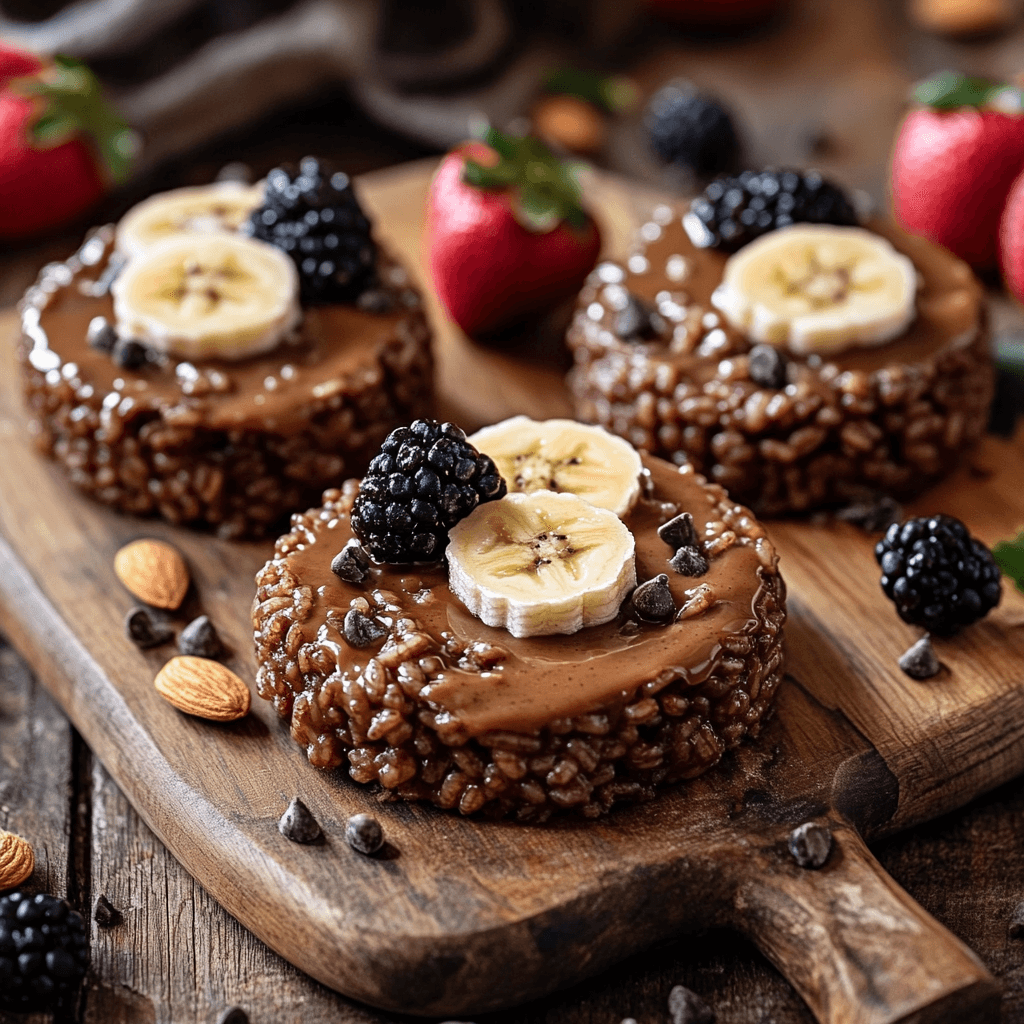
While chocolate rice cakes may not be a nutritional powerhouse, they can be part of a healthy diet when consumed mindfully. Here are practical tips for enjoying chocolate rice cakes without compromising your health goals.
Pairing Chocolate Rice Cakes with Nutritious Foods
One of the easiest ways to enhance the nutritional value of chocolate rice cakes is by pairing them with healthier toppings or side dishes.
- Add Protein:
Pairing chocolate rice cakes with high-protein foods can help balance their low protein content. Examples include:- A dollop of Greek yogurt.
- A smear of peanut or almond butter.
- A side of hard-boiled eggs or a protein shake.
- Boost Fiber:
Add toppings rich in fiber to slow digestion and keep you feeling full longer:- Fresh fruit slices, such as bananas, strawberries, or apples.
- A sprinkle of chia or flax seeds.
- A layer of mashed avocado for a savory twist.
- Incorporate Healthy Fats:
Healthy fats improve satiety and make the snack more balanced. Ideas include:- A few slices of avocado.
- Crushed walnuts, almonds, or pistachios.
- A drizzle of olive oil or tahini.
Practice Portion Control and Moderation
While chocolate rice cakes are lower in calories than many snacks, it’s still important to consume them in moderation. Eating too many can lead to excess calorie and sugar intake, defeating their purpose as a healthier alternative.
- Stick to 1–2 Rice Cakes Per Serving:
This keeps calories and sugar manageable while still satisfying your sweet tooth. - Don’t Rely on Them for Daily Snacks:
Rotate chocolate rice cakes with other nutrient-dense snacks like nuts, yogurt, or fresh fruit to ensure your diet remains well-balanced.
Choose Healthier Brands
Not all chocolate rice cakes are created equal. Selecting a healthier brand can make a big difference in their overall impact on your diet.
- Look for Lower Sugar Content:
Brands with less than 5 grams of sugar per rice cake are better for blood sugar control. - Check for Whole Grains:
Rice cakes made from whole-grain or brown rice are slightly higher in fiber and nutrients than those made from refined white rice. - Avoid Artificial Additives:
Choose options free of artificial flavors, colors, and preservatives. Organic brands often meet these criteria.
Timing Your Snack Wisely
Chocolate rice cakes can be a good snack in certain situations:
- Post-Workout: Their carbohydrates help replenish glycogen stores after exercise. Pair with a protein source like a shake or nuts for recovery.
- Midday Pick-Me-Up: A chocolate rice cake with a bit of nut butter or fruit can provide an energy boost without leading to a sugar crash.
Homemade Chocolate Rice Cakes for Better Control
If you want to ensure the highest quality ingredients and reduce added sugars, consider making chocolate rice cakes at home.
- Ingredients: Plain rice cakes, melted dark chocolate, and optional toppings like nuts, seeds, or shredded coconut.
- Instructions:
- Melt dark chocolate and spread a thin layer on each rice cake.
- Add your chosen toppings before the chocolate hardens.
- Let the rice cakes set in the fridge and store in an airtight container.
This DIY approach allows you to control sugar and add nutrients while enjoying a delicious snack.
Integrating Them into a Healthy Lifestyle
Chocolate rice cakes work best as part of an overall balanced diet that includes:
- A variety of whole foods like vegetables, fruits, lean proteins, and whole grains.
- Mindful eating practices to prevent overindulgence.
- Regular physical activity to maintain overall health.
By following these guidelines, chocolate rice cakes can fit seamlessly into your dietary routine as an occasional treat or convenient snack.
FAQs Chocolate Rice Cakes Healthy
Are chocolate rice cakes good for weight loss?
Yes, when eaten in moderation, chocolate rice cakes can be a low-calorie snack option for weight loss. Pair them with protein or fiber-rich foods to feel fuller for longer.
Can chocolate rice cakes be eaten as a post-workout snack?
Yes, they provide quick-digesting carbohydrates that can replenish energy after exercise. Pair them with a protein source to optimize recovery.
Are chocolate rice cakes suitable for kids?
Yes, they can be a kid-friendly snack. However, check the sugar content and consider pairing them with fruit or yogurt for added nutrition.
Are there vegan options for chocolate rice cakes?
Many brands offer vegan-friendly chocolate rice cakes by using dairy-free chocolate. Always check the label to confirm.
Do chocolate rice cakes cause a sugar spike?
Yes, they can cause a quick rise in blood sugar due to their high glycemic index, especially if they contain added sugar. Pairing them with fiber or protein can help mitigate this effect.
Can chocolate rice cakes be part of a gluten-free diet?
Yes, most chocolate rice cakes are naturally gluten-free, but always verify the label for cross-contamination risks.
Conclusion
Chocolate rice cakes are a versatile snack that can fit into a healthy diet when consumed thoughtfully. They offer a low-calorie, gluten-free option for those looking to satisfy a sweet craving. However, their low nutrient density, high glycemic index, and potential sugar content mean they should be enjoyed in moderation and paired with other nutrient-rich foods.
By making smart choices, such as selecting healthier brands or creating homemade versions, you can enjoy chocolate rice cakes while supporting your overall health and wellness goals.
Print
Are Chocolate Rice Cakes Healthy?
Description
Notes
Health Benefits:
✅ Low in Calories – Plain rice cakes are generally low in calories, making them a good snack option for those watching their intake.
✅ Gluten-Free (Usually) – Most rice cakes are made from puffed rice and are naturally gluten-free, which can be beneficial for those with gluten sensitivities.
✅ Light and Crunchy – They can satisfy a craving for something crunchy without being as heavy as chips or cookies.
Potential Downsides:
⚠️ High in Sugar – Many chocolate-coated rice cakes contain added sugars and unhealthy fats, which can increase calorie content and lead to blood sugar spikes.
⚠️ Low in Nutrients – Rice cakes, even with chocolate, do not provide much protein, fiber, or essential vitamins and minerals.
⚠️ Can Cause Blood Sugar Spikes – Since rice cakes are high in refined carbohydrates, they can quickly raise blood sugar levels, especially if not paired with protein or healthy fats.
Healthier Alternatives:
- Choose dark chocolate-covered rice cakes instead of milk chocolate to get more antioxidants and less sugar.
- Opt for plain rice cakes with a spread of nut butter and dark chocolate shavings for a more balanced snack.
- Look for low-sugar options or brands that use natural sweeteners like stevia.
